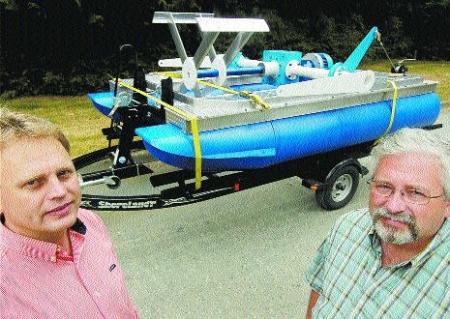

Ocean energy adrift in B.C.
Province not taking the initiative to become a world leader
Paul Luke
The Province
Sunday, July 27, 2008

New Energy Corp.'s president and CEO Clayton Bear (left) and business development vice-president
Bob Moll are among those pushing development of ocean energy across Canada.
CREDIT: Gerry Kahrmann, The Province
B.C.'s chance to become a global leader in ocean energy may drift out of reach unless the province decides to help the infant industry stay afloat.
Canada's west coast is blessed with enormous ocean energy resources and a handful of companies with world-beating technology, says Chris Campbell, executive director of Nanaimo-based Ocean Renewable Energy Group.
But unlike several European countries, B.C. has shown little desire to nurture the industry. Campbell predicts B.C. will be generating a significant amount of wave and tidal power in 15 to 20 years, but he worries that it may be using foreign technology.
"We're really at a critical point," says Campbell, whose non-profit organization pushes development of ocean energy across Canada.
"When we put in a wind farm or even a run-of-river project we're buying that technology from somewhere else."
"We've got a B.C.-based wave and tidal technology that could be among the world's leaders but if don't do something soon we may as well just get the box cutters out and open the boxes with the Scottish thistles on them."
Campbell is referring to the United Kingdom's aggressive support for ocean energy research and development over much of the past decade. While there's no clearcut leader in ocean energy technology -- "that's going to be decided over the next four to five years" -- Scotland may emerge as the country to beat, he says.
Vancouver-based Clean Current Power Systems could spoil that for the Scots. Clean Current has developed technology to convert the kinetic energy of tidal currents into electricity.
Clean Current has tested three prototype tidal turbines. One of these, a 65-kilowatt device, was tried out two years ago in the Race Rocks ecological reserve near Victoria.
The company is currently designing and building a commercial-scale turbine with a 17-metre diameter blade to be installed in the Bay of Fundy off Nova Scotia by fall of 2009.
Clean Current CEO Glen Darou says his company's turbines, which work like underwater windmills, are among the few such devices with a proven track record.
"There are something like 46 tidal energy businesses," Darou told last week's meeting of the Pacific NorthWest Economic Region in Vancouver. "There are only about four that have actually been in salt water operating."
B.C.'s other ocean energy companies have yet to go as far towards commercialization. That's one reason the industry was crestfallen when the provincial government bypassed it for funding earlier this month.
No ocean energy initiatives were among the first 15 projects chosen for funding from the government's $25-million Innovative Clean Energy Fund.
Nigel Protter, president of Pemberton-based SyncWave Systems, says B.C. is swimming in a policy vacuum when it comes to ocean energy.
"The possible outcomes of the B.C. government's neglect of the industry is that companies are withering, will wither and may have to leave," Protter told the PNWER meeting.
SyncWave's made-in-B.C. technology targets ocean energy's other stream: wave power. Its system absorbs energy from waves by resonating to the ocean's wave frequencies.
SyncWave hopes to have a demonstration device in the ocean next year. By 2012, it wants to have hybrid wave-diesel systems in place to serve remote communities.
Alberta's New Energy Corp. had, until recently, focused on extracting energy from freshwater streams. The company is developing tidal current applications for its technology by partnering with Campbell River-based Canoe Pass Tidal Energy.
The partners plan to develop tidal-current projects in the channel between Quadra and Maude islands. New Energy hopes to have two 250-kilowatt turbines in the water next year for demonstration purposes, says Bob Moll, New Energy's vice-president of business development.
B.C., the northern tip of Scotland and, perhaps, Chile are among the few areas in the world endowed with immense tidal and wave resources. Mike Tarbotton, head of Vancouver-based Triton Consultants, says B.C. has about 89 tidal energy sites adding up to about 4,015 megawatts of power.
Annual mean wave power off B.C.'s coast totals about 37,000 megawatts, according to a two-year-old inventory by the Canadian Hydraulics Centre.
On paper, that's equivalent to about half of Canada's electricity consumption. In practice only a fraction can be converted into useful power.
Ocean power, which is not affected by changing levels of precipitation, should become part of B.C.'s energy portfolio, Campbell argues.
Ocean energy projects, however, are expensive in their early stages. Venture capitalists after quick payoffs haven't exactly been flinging money at a sector that, like wind energy before it, will need years to test technology and cut costs.
B.C. Hydro, Campbell suggests, could commit to pay for 20 to 50 megawatts of installed ocean power capacity without imposing a heavy burden on ratepayers.
"We need to build an environment that makes it a little easier to attract financial investment," Campbell says. "That isn't simply government writing a cheque, although that helps, but government flying a flag that says we want to see ocean energy as part of the mix for British Columbia."
© The Vancouver Province 2008
Posted by Arthur Caldicott on 29 Jul 2008